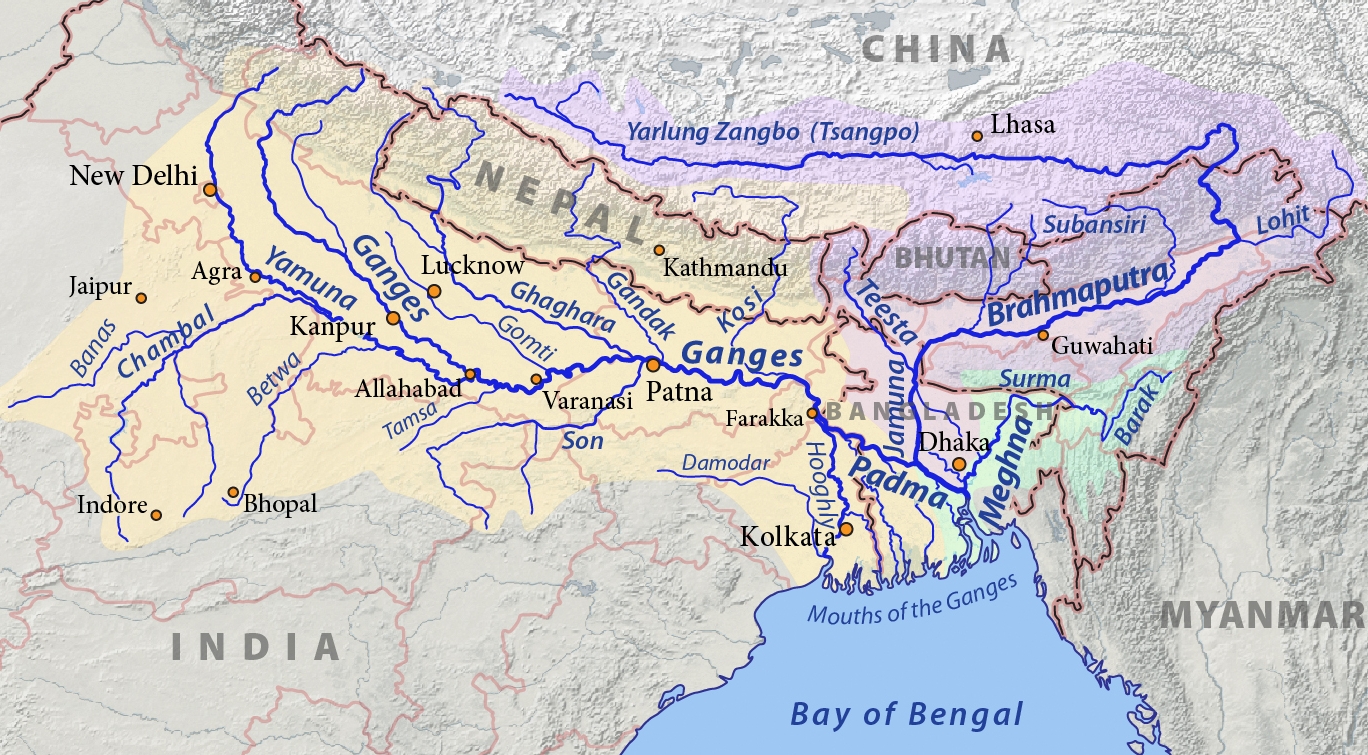
Der Brahmaputra ist der Hauptstrang des als Meghna in den Indischen Ozean mündenden wasserreichsten Stromes in Asien. Er fließt mit einer Länge von rund 3100 Kilometern bis zum Zusammenfluss mit dem Ganges durch das Gebiet der Staaten China, Indien und Bangladesch. Sein Lauf ist teils veränderlich, teils schwer zugänglich und quert mehrere Kulturräume, was zu vielen unterschiedlichen Namen für Teilabschnitte geführt hat.
Der nach Osten gerichtete Oberlauf des Brahmaputra in Tibet heißt auf Tibetisch Matsang bzw. Tachog Tsangpo (in Wylie-Transliteration: rta mchog gtsang po), auf Chinesisch Mǎquán Hé 馬泉河 / 马泉河; danach heißt er auf Tibetisch Yarlung Tsangpo ཡར་ཀླུང་གཙང་པོ (yar klung gtsang po), der Reinigende, nach anderer Quelle „vom höchsten Gipfel herabkommendes Wasser“, und auf Chinesisch Yǎlǔ Zàngbù Jiāng 雅魯藏布江 / 雅鲁藏布江.
Im indischen Bundesstaat Arunachal Pradesh hat der scharf nach Süden abgeknickte Fluss den Namen Dihang oder Siang. Nach einem Richtungswechsel nach Westen an der Einmündung des größten Nebenflusses, des Lohit, heißt er, nun den Bundesstaat Assam durchfließend, Brahmaputra (ब्रह्मपुत्र), was im Sanskrit „Sohn des Brahma“ bedeutet. Ein älterer Name dieses Flussabschnittes war (in Sanskrit-Schriften und in Teilen Assams) Luit oder Lohitya, da früher statt des größeren Dihang der Lohit als der Oberlauf galt. Heute wird der Name auf Hindi ब्रह्मपुत्र, Brahmaputra gesprochen, auf Assamesisch ব্ৰহ্মপুত্ৰ und auf Bengalisch ব্রহ্মপুত্র Brohmoputro.
Bei einer Wendung nach Süden tritt der Fluss in das Staatsgebiet von Bangladesch ein und führt teils ab dort, teils ab der Abzweigung des Alten Brahmaputra (früher der Hauptstrom) den Namen Jamuna. Ab dem Zusammentreffen mit dem deutlich weniger voluminösen Ganges schwenkt der Strom in dessen südöstliche Richtung ein und heißt nun Padma, bis er ab der Mündung des letzten großen Nebenflusses bis zur Mündung in den Golf von Bengalen dessen Namen Meghna annimmt.
布拉马普特拉河,亚洲主要大河之一,被藏族视为“摇篮”和“母亲河”。以长度来说为中国第5大河(仅次于长江、黄河、黑龙江和珠江)、西藏地区第一大河,以水量来说是印度和孟加拉国的第二大河(仅次于恒河)。上游是世界海拔最高的大河,也是中国坡降最陡的大河。藏语中雅鲁藏布江意为“高山流下的雪水”,梵语中布拉马普特拉河意为“梵天之子”。它发源于西藏喜马拉雅山脉北麓的杰马央宗冰川,从藏南(印度称阿鲁纳恰尔邦)进入印度,在藏南(阿鲁纳恰尔邦)境内称底杭河(Dihang river)或香江(Siang river)。在藏南巴昔卡附近的印度阿萨姆邦境内与其他两河合流后始称布拉马普特拉河。流经孟加拉国后称为贾木纳河,于瓜伦多卡德与恒河汇合,形成巨大的恒河三角洲,最后注入孟加拉湾。全长为2900公里。
布拉马普特拉河(梵語:ब्रह्मपुत्र,印地語:ब्रम्हपुत्र)字面意思是“(印度教三主神之一的)梵天之子”,南亚的一条重要国际河流。
布拉马普特拉河的上游在中国境内,称为雅鲁藏布江,长2057km;流入印度后称为布拉马普特拉河,长644km;流入孟加拉国后称贾木纳河,长240km;在阿里恰与恒河汇流后称帕德玛河,长100km;在琴德普尔与梅格纳河汇合后仍称梅格纳河长241km;最后注入孟加拉湾。以水量、长度来说,此河是南亚第一大河。包括上游雅鲁藏布江在内的全长为2900公里。总流域面积6.22×105km2,流域国有中国、印度、不丹、孟加拉国,四国分别占该河流域面积的51.1%、34%、6.7%、8.2%。
ブラマプトラ川(ブラマプトラがわ、英:Brahmaputra River, ヒンディー語:ब्रह्मपुत्र Bramhaputra, ベンガル語:ব্রহ্মপুত্র Brohmoputro)は、チベットに発しバングラデシュでガンジス川と合流し、ベンガル湾へ注ぐ河川である。チベットではヤルンツァンポ川(表記によってはヤル・ツアンポー川とも。チベット語:ཡར་ལུང་གཙང་པོ་ Yar-lung gTsang-po, 中国語:雅鲁藏布江)、バングラデシュではジョムナ川(英:Jamuna River, ベンガル語:যমুনা Jomuna)と呼ばれている。 全長2,900km。源流はヒマラヤ山脈の北側で、マーナサローワル湖から流れでてチベット高原南部を東進した後ヒマラヤ山脈東端をかすめ南下、インドのアッサム州を西へ向け横断、ガンジスに合流する。その合流点では世界最大の広大な三角洲を形成している。中流から下流域にかけて堆積平野が広がり、主に農業が営まれる。雨季にはしばしば氾濫し、氾濫のためにできた沼沢地や池が残る。
The Brahmaputra (/ˌbrɑːməˈpuːtrə/) is one of the major rivers of Asia, a trans-boundary river which flows through China, India and Bangladesh. As such, it is known by various names in the region: Assamese: লুইত luit [luɪt], ব্ৰহ্মপুত্ৰ নৈ Brohmoputro noi, ব্ৰহ্মপুত্ৰ নদ (the tatsama 'নদ' nod, masculine form of the tatsama 'নদী' nodi "river") Brohmoputro [bɹɔɦmɔputɹɔ]; Sanskrit: ब्रह्मपुत्र, IAST: Brahmaputra; Tibetan: ཡར་ཀླུངས་གཙང་པོ་, Wylie: yar klung gtsang po Yarlung Tsangpo; simplified Chinese: 布拉马普特拉河; traditional Chinese: 布拉馬普特拉河; pinyin: Bùlāmǎpǔtèlā Hé. It is also called Tsangpo-Brahmaputra (when referring to the whole river including the stretch within Tibet).[2] The Manas River, which runs through Bhutan, joins it at Jogighopa, in India. It is the ninth largest river in the world by discharge, and the 15th longest.
With its origin in the Manasarovar Lake region, located on the northern side of the Himalayas in Burang County of Tibet as the Yarlung Tsangpo River,[1] it flows across southern Tibet to break through the Himalayas in great gorges (including the Yarlung Tsangpo Grand Canyon) and into Arunachal Pradesh (India).[3] It flows southwest through the Assam Valley as Brahmaputra and south through Bangladesh as the Jamuna (not to be mistaken with Yamuna of India). In the vast Ganges Delta, it merges with the Padma, the popular name of the river Ganges in Bangladesh, and finally the Meghna and from here it is known as Meghna before emptying into the Bay of Bengal.[4]
About 3,848 km (2,391 mi)[1] long, the Brahmaputra is an important river for irrigation and transportation. The average depth of the river is 38 m (124 ft) and maximum depth is 120 m (380 ft). The river is prone to catastrophic flooding in the spring when Himalayas snow melts. The average discharge of the river is about 19,800 m3/s (700,000 cu ft/s),[3] and floods can reach over 100,000 m3/s (3,500,000 cu ft/s).[5] It is a classic example of a braided river and is highly susceptible to channel migration and avulsion.[6] It is also one of the few rivers in the world that exhibit a tidal bore. It is navigable for most of its length.
The river drains the Himalaya east of the Indo-Nepal border, south-central portion of the Tibetan plateau above the Ganga basin, south-eastern portion of Tibet, the Patkai-Bum hills, the northern slopes of the Meghalaya hills, the Assam plains, and the northern portion of Bangladesh. The basin, especially south of Tibet, is characterized by high levels of rainfall. Kangchenjunga (8,586 m) is the only peak above 8,000 m, hence is the highest point within the Brahmaputra basin.
The Brahmaputra's upper course was long unknown, and its identity with the Yarlung Tsangpo was only established by exploration in 1884–86. This river is often called Tsangpo-Brahmaputra river.
The lower reaches are sacred to Hindus. While most rivers on the Indian subcontinent have female names, this river has a rare male name, as it means "son of Brahma" in Sanskrit (putra means "son").[7]
Le Brahmapoutre - du sanskrit ब्रह्मपुत्र (Brahmaputra) signifiant « fils de Brahmâ »3 - est un fleuve de l'Asie du Sud, long de 2 900 kilomètres, ayant sa source principale dans l'Himalaya tibétain, à 5 542 m d'altitude, au glacier Gyima Yangzoin, dans le xian de Zhongba 29° 17′ 41″ N, 83° 46′ 23″ E 4. D'autres sources sont situées au pied des glaciers des monts Kubi-gangri et Ganglung-gangri. C'est le Dyardanes ou l’Œdanes des Grecs anciens. Son parcours tropical fait de la vallée de ce fleuve un des plus riches sites mondiaux au regard de la biodiversité. Ses crues importantes permettent une fertilisation du sol mais sont dévastatrices. Dans son cours inférieur, qui est sacré pour les hindous, le fleuve est utilisé pour le transport de produits agricoles.
Il Brahmaputra (ཡར་ཀླུང་གཙང་པོ་ in tibetano, 布拉马普特拉河 in cinese) è un fiume che nasce nel Tibet sud-occidentale, dove prende il nome Yarlung Tsangpo, e scorre verso est, lungo il versante settentrionale dell'Himalaya, in territorio cinese. Dopo avere aggirato la catena himalayana, piega bruscamente a sud, e col nome di Brahmaputra attraversa gli stati indiani dell'Arunachal Pradesh e dell'Assam, entrando poi nel Bangladesh, dove confluisce nel Gange in corrispondenza del delta di questo per sfociare nel golfo del Bengala.
È lungo 2.900 km, ha una profondità media di 38 metri e massima di 120, si dirama spesso in un intreccio di bracci soggetti a fenomeni di avulsione ed è uno dei pochi fiumi al mondo in cui si verifica la cosiddetta marea fluviale. Il suo bacino idrografico copre una superficie di 670.000 km².[1]
Ha un regime idrico caratterizzato da portata sempre elevatissime: le minime non scendono mai sotto i 5.000 m³/s, ma le massime possono raggiungere anche i 168.500 m³/s, si tratta di portate massime che trovano paragone solo nel Rio delle Amazzoni ed in pochissimi altri fiumi del pianeta. Durante l'estate, quando lo scioglimento dei ghiacciai coincide con l'arrivo del monsone, il fiume è soggetto a catastrofiche esondazioni, che insieme a quelle del Gange allagano intere regioni e sommergono buona parte del Bangladesh, causando ingenti perdite di vite umane e gravissimi danni alle abitazioni e all'agricoltura.[2]
È navigabile per buona parte del suo corso, ma nell'ultima parte del tratto tibetano è caratterizzato da un corso assai impetuoso, con rapide e cascate (una, alta circa 35 metri, è stata scoperta dopo il 2000 nel corso di un'esplorazione britannica). A causa delle gole inaccessibili che attraversa in questa zona disabitata, per lungo tempo non si seppe che il Brahmaputra e lo Yarlung fossero lo stesso fiume, la continuità tra i due corsi è stata scoperta da un'esplorazione compiuta tra il 1884 ed il 1886.
El río Brahmaputra (en idioma sánscrito, ब्रह्मपुत्र, que significa «el hijo de Brahmā») es uno de los ríos más largos de Asia.
Nace en el glaciar Kubigangri, cerca del monte Kailāsh, en el Himalaya, y discurre en dirección este por territorio chino, por la parte oeste del Tíbet, pasando cerca de Lhasa. Después de un recorrido de 2896 km desagua en el golfo de Bengala, en Bangladés, formando parte del delta del Ganges, el mayor delta del mundo. El río es conocido como Tsangpo en el Tíbet y en la zona central de Bangladés se divide en dos ramales, siendo el principal el río Jamuna, nombre con el que es conocido en esa región, y el otro, de menor caudal, el río Shitalakshya.
Es el Dyardanes o "Œdanes" de los antiguos griegos. Su recorrido por la zona tropical hace de su valle uno de los más ricos en diversidad biológica del mundo. Sus principales inundaciones permiten la fertilización del suelo, aunque son devastadoras. En su parte más baja, el río se considera sagrado para los hindúes, y se utiliza para el transporte de productos agrícolas.
Брахмапу́тра[2] (кит. 雅鲁藏布江, тиб. ཡར་ཀླུང་གཙང་པོ།, хинди ब्रह्मपुत्र, ассам. ব্ৰহ্মপুত্ৰ, англ. Brahmaputra, бенг. ব্রহ্মপুত্র) — река в Китае, Индии и Бангладеш, левый приток Ганга; одна из крупнейших водных артерий в Южной Азии.








